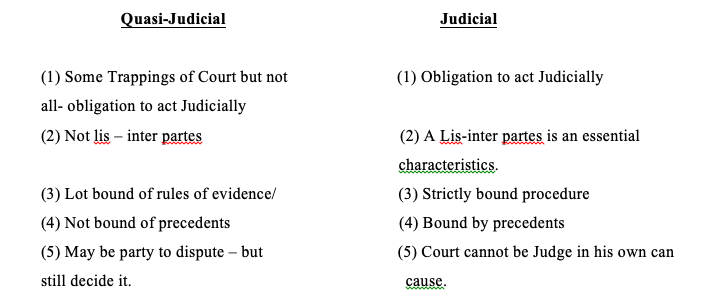Classification of Administrative Functions as purely Legislative, Administrative and Judicial


Author – Megha Pandey
Co-Author – Harsha Tiwari
Amity Law School Noida
Classification of Administrative Functions as purely Legislative, Administrative and Judicial
Administrative action is a comprehensive term and defies exact definition. In modern times the administrative process as a byproduct of intensive form of government cuts across the traditional classification of governmental powers and combines into one all the powers which were traditionally exercised by three different organs of the State.
The administration is the meeting point of the three types of governmental functions, namely legislative, judicial and administrative. Usually, the executive performs the reside of all those functions which are not vested in the other two branches of the government i.e. the legislature and the judiciary. In the administrative process, all the three functions, which are traditionally vested in the three different organs of government are telescoped into one single authority.
There are three organs of Government- legislature, executive and Judiciary. These three organs essentially perform three classes of governmental functions- Legislative, executive and judicial. The function of the legislature is to enact law; the executive is to administer the law and the judiciary is to interpret the law and to declare what the law is. Although the term ‘the Executive’ or ‘the administration’ is employed, there is no implication that the function of the executive are confined exclusively to those of an executive or administrative character.
Today the executive performs variegated functions, viz. to investigate, to prosecute, to prepare and to adopt schemes, to issue and cancel licences, etc. (administrative); to make rules, regulations and bye-laws, to fix prices etc. (legislative); to adjudicate on disputes, to impose fine and penalty, etc. (judicial).
In Jayantal Amritlal Shodhan v. F.N. Rana, the SC observed that it cannot be assumed that the legislative functions are exclusively performed by the legislature, executive functions by the executive & judicial functions by the judiciary.
Thus, speaking generally, an administrative action, can be classified into three categories:
1. Quasi-legislative action or rule-making action;
2. Quasi-judicial action or Rule-decision action; and
3. Purely Administrative action or Rule application action.
NEED FOR CLASSIFICATION
- A question arises as to whether the functions performed by the executive authorities are purely administrative, quasi-judicial or quasi-legislative in character. The answer is very difficult as there is no precise, scientific and perfect test to distinguish these functions from one another.
- A further difficulty arises in a case in which a single proceeding may at times combine various aspects of the three functions. The courts have not been able to formulate any definite test for the purpose of making such classification. Yet such classification is essential and inevitable as many consequences flow from it, e.g., if the executive authority exercises a judicial or quasi-judicial function, it must follow the principles of natural justice and is amenable to the writ of certiorari or prohibition, but if it is an administrative, legislative or quasi-legislative function, this is not so.
- If the action of the executive authority is legislative in character, the requirement of publication, laying on the table etc. should be complied with, but it is not necessary in the case of a pure administrative action.
- Again, if the function is administrative, delegation is permissible, but if it is judicial, it cannot be delegated. An exercise of legislative power may not be held invalid on the ground of unreasonableness, but an administrative decision can be challenged as being unreasonable. It is therefore necessary to determine what type of function administrative authority performs.
LEGISLATIVE, EXECUTIVE AND JUDICIAL FUNCTIONS (PURELY) & THEIR DISTINCTION
Legislative functions
When any administrative authority exercises the law making power delegated to it by legislature, it is known as the rule making action of the administration or quasi legislative action. The legislative functions of the executive consist of making rules, regulations, bye-laws etc.
If a particular function is termed ‘legislative’ or ‘rule making’ rather than ‘judicial’ or ‘adjudication’ it may have substantial effects upon the parties concerned. If the function is treated as legislative in nature, there is no right to a notice and hearing unless a statute expressly requires them.
- Legislative & Judicial Functions: Distinction
In Prentis vs. Atlantic Coastline Co. Justice Holmes points out the distinction.
Judicial :
(1) Judicial inquiry investigates, declared & enforces liabilities and they stand – on present or past facts & under existing Law. That is the purpose and end.
Legislative :
(1) Looks to the future and changes existing condition by making new rules to be applied to all persons.
According to Justice Holmes: Main aspect is the element of time.
(i) A rule (Legislative Function) prescribes future pattern of Conduct and creates new rights and Liabilities.
(ii) Whereas decision (Judicial) determines rights & Liabilities function on the basis of present & past facts and declares the pre existing rights & Liabilities.
- Legislative & Administrative Functions: Distinction
Distinction between Legislative & Administrative Function is very difficult to draw. In Baldev Singh v. State of HP, an action of inclusion of certain areas within the municipal corporation was held to be administrative, while in Sunderjas Bhatija v. Collector, such action was held to be legislative.
The power to make rules of general application is a legislative power and the rule is a Legislative rule. Power to give order in specific cases is an executive power & the order is an executive action.
Legislative Act is the creation & promulgation of a general rule of conduct without reference to particular conduct while administrative act is the application of a general rule to a particular case.
Judicial functions
According to committee on Ministers Power – Pure Judicial Function pre supposes an existing dispute between two or more parties & dispute between two or more parties & it involves four requisites.
- Presentation of their cause by the parties to the dispute
- If the dispute is question of fact- ascertainment by evidence, arrangements etc.
- If the dispute is question of Law submission of Legal argument by the parties.
- A decision- by finding facts in dispute & application of Law to the facts— ruling upon disputed question of Law. Thus in a pure judicial function – The aforesaid if requisites must be present the decision is Judicial decision even though it might have been made by Minister, Board Exe-authority Adm./ officer, tribunal etc.
1. Quasi-Judicial function
“Quasi” means “not exactly”. Generally an authority is described as quasi-Judicial when it has some attributes or trappings of judicial functions but not all.
Griffith and Street – Stated that quasi judicial function stands midway between judicial function & Adm. Function. Quasi Judicial decision — is nearer to administrative decision in terms of discretionary element & nearer the judicial decision in terms of procedure & objectivity of its end product.
2. Quasi-Judicial & Judicial: Distinction

Administrative Functions
In Ram Jawaya V/s State of Punjab, Mukherjee C.J. observed. “It may not be possible to frame an exhaustive definition of what executive functions means and implies.
Ordinarily the executive power connotes the residence of Govt. function that remains after Legislative & Judicial functions are taken away.
Following characteristics are inherent in Administrative functions:
(1) Administrative order generally based on Govt. policy/ expediency.
(2) In administrative decision – no legal obligation to adopt judicial approach—decision—subjective.
(3) Not bound by the rules of evidence of procedure.
(4) Can take decision in exercise of statutory powers or in the absence of statutory provisions.
(5) Administrative functions – delegated / Sub-delegated
(6) Administrative authority may consider evidence, even use discretion.
(7) Administrative authority is not always bound principle of natural justice unless statutory provision.
(8) Administrative action may be held invalid on the ground of unreasonableness.
(9) Writs of prohibitions/ certiorari are not always available against administrative actions.
Administrative and Quasi-Judicial functions: Distinction
To appreciate the distinction between administrative & quasi-judicial functions- we have to understand two expressions.
(i) Lis: In Province of Bombay v. Khushaldas Advani, J. Das observed that- “if a statute empowers an authority to decide dispute arising out claim by one party, which is opposed by another party.”
“When there is a lis inter partes and administrative authority is required to decide dispute between parties & to adjudicate upon the lis. In such cases the authority will be regarded as acting in quasi-judicial manner.”
(ii) Quasi-lis: Lis decided not between two or more parties but between itself & another party. (not list inter partes). Thus, where an authority makes an order dismissing employee, canceling admission to student refusing unfair means, rusticating students, such decisions are extra judicial in nature.
CLASSIFICATION OF PURE ADMINISTRATIVE FUNCTION
Pure administrative function can be divided into three categories:
(a) Administrative discretion
(b) Ministerial action
(c) Administrative instruction
Administrative discretion:
In Layman’s language, discretion means choosing from amongst the various available alternatives without reference to nay predetermined criterion, no matter how fanciful that choice may be.
CJ. Coke says– Discretion is a science or understanding to discern between falsity and truth, between right and wrong and not to do according to will and private affection.
The problem of administrative discretion is complex. It is true that in any intensive form of government cannot function without the exercise of some discretion by the officials. It is necessary not only for individualization of the administrative power but also because it is humanly impossible to lay down a rule for every conceivable eventuality in the complex art of modern government. But it is equally true that absolute discretion is a ruthless master.
Ministerial action:
Ministerial function is that function of agency which is taken as a matter of duty imposed upon it by the law devoid of any discretion or judgment. Therefore, a ministerial action involves the performance of a definite duty I respect of which there is no choice, no wish and no freedom. Here, the high authority dictates and lower authority carries out. Collection of revenue may be one such ministerial action.
When an administrative agency is acting ministerially it has no power to consult its own wishes but when it is acting administratively its standards are subjective and it follows its own wishes.
Administrative instruction:
Administrative instruction means power to issue instruction flow from the general executive power of the administration. ‘Administrative instruction’ is a most efficacious technique for achieving some kind of uniformity in administrative discretion and to manipulate in an area which is new and dynamic. These instructions also give a desired flexibility to the administration devoid of technicalities of the rule-making process.
The instructions which are generally issued not under any statutory authority but under the general power of administration are considered as directory and hence are unenforceable not having the force of law.
If administrative instructions have no force of law but if these are consistently followed for a long time government cannot depart from it at its own sweet will without rational justification.
LEADING CASES
1. A.K. Kraipak v. Union of India
FACTS: In 1966, the Indian forest service was constituted, the selection for which was to be made from among the officers serving in the forest department of the State. The rule made under Section 2(A) of the All India Services Act, 1951 by the Central Government provided for setting up of a Special Selection Board whose function would be to recommend officers for selection to the central service and it was to be headed by the chief conservator of forest of that state. The final selections were to be made by the UPSC. In the state of Jammu & Kashmir, one Naquishbund was appointed as acting chief conservator of forest and hence was appointed as the ex-officio chairman of the Selection Committee. Two persons senior to him had been superseded and they had filed petitions against this to higher authorities regarding this. Meanwhile, the selection committee had to recommend names and it so happened that they recommended the names of person in which Naquishbund was included but excluding the two senior officers who had been superseded, who were all candidates to the Indian forest service. The recommendations of the Board were submitted to the UPSC. The recommendation was challenged on the ground that a person who had been recommended was the chairman of the board and that it had violated the requisites of fair hearing and apparently violated the principles of natural justice.
ISSUES: ï Whether the principle of natural justice applied to administrative proceedings assuming that the present proceedings are administrative in nature?
ï Whether there was a violation of such principles of natural justice in the present case?
JUDGMENT: A five judge bench of the Apex Court held that the selections made by the selection committee were in violation of principles of natural justice.
The Hon’ble Court found the power exercised by the Selection Board as an administrative one and tested the validity of the selections on that basis. It held that the concept of rule of law would lose its importance if the instrumentalities of the State are not charged with the duty of discharging their functions in a fair and just manner. Also, it is a must to charge administrative authorities with the duty of discharging their functions in a fair and just manner in a Welfare State like India, where the jurisdiction of the administrative bodies is increasing at a rapid rate.
In this case the Supreme Court held that though the action of making selection for government service is administrative, yet the selection committee is under a duty to act judicially. The Court observed that the dividing line between an administrative power and quasi-judiciai power is quite thin and being gradually obliterated.
CONCLUSION: Therefore what emerges from this case is that although the Courts are making distinctions between the Quasi-Judicial and Administrative powers but at the same time there is one common element of fair procedure in both the cases which can be referred to as the ‘duty to act fairly’. This duty arises from the same general principles, as do the rules of natural justice.
2. D.K. Yadav v. J.M.A. Industries Ltd.
The Supreme Court further observed that the distinction between quasi-judicial and administrative action which had become thin is now totally eclipsed and obliterated.
3. Amitabh Shirivastava v. State of M.P.
The court allowed the enforceability of administrative instructions even in view of the fact that they modified statutory rules. In the instant case, the state Government had prescribed certain qualifying marks by statutory rules for admission to medical colleges in the state. The petitioner did not qualify for admission on the basis of these rules. Subsequently, the qualifying percentage of marks was lowered by an executive order, on the basis of which the petitioner became eligible for admission.
The Supreme Court allowed admission to the petitioner by enforcing an administrative instruction as against the rules. The only justification which the court found for its ruling appears to be that the government did not object to the enforceability of an administrative direction at the instance of an individual. However, in decisions the Supreme Court held that exclusive instructions can supplement a statute or cover areas to which the statute does not extend. But they cannot run contrary to statutory provisions or whittle down their effect.
CONCLUSION
The literature of classification of administrative action is rather confused. To solve this problem, we only need to keep a few necessary classifications in terms of function, while bringing other large numbers of classifications into relevant principles introduction and discussion. In the sense of connotation of administrative action, notion reconstruction is unnecessary for the thoroughly overhauling can well meet the need. That is, defining administrative action as the function of administrative power and to classify it level by level.
In view of the system construction of administrative law, defining scope of administrative remedies is not fully decided by the classification of administrative action. So there is no need to unduly attack the division of general administrative action and specific administrative action. Such division mainly serves to build up the self-discipline system of legal administration. Moreover, from the perspectives of drawing Administrative Procedural Act and gathering statistics of administrative acts, it’s also necessary to define administrative action as the function of administrative power and to classify it level by level.
Administrative law is the law governing the Executive, to regulate its functioning and protect the common citizenry from any abuse of power exercised by the Executive or any of its instrumentalities. It is a new branch of law which has evolved with time and shall continue to evolve as per the changing needs of the society. The aim of administrative law is not to take away the discretionary powers of the Executive but to bring them in consonance with the ‘Rule of law’.
1 https://shodhganga.inflibnet.ac.in/bitstream/10603/132460/9/09_chapter%202.pdf
2 Schwartz, Administrative Law (1976) p. 31.
3 https://www.coursehero.com/file/32167111/Classification-of-administrative-functionspdf/
4 AIR 1964 SC 648
5 Administrative Law, C.K.Takwani, 5th edition, Eastern Book Company publication
6 Administrative Law, C.K.Takwani, 5th edition, Eastern Book Company publication
7 53 L Ed 150L 211 US 210 (1908)
8 (1987) 2 SCC 510
9 1989 SCR (3) 405
10 De’Smith – (J.R.Q. Adm. action — 1995 P. 1006)
11 Report of the committee on ministers’ power, 1932
12 Principles of Administrative Law
13 AIR 1955 SC 549
14 [Madhavrao Sciendia v. UOI (1971) 1 SCC 85]
15 http://aclawresearch.blogspot.com/2012/12/what-is-classification-of-pure.html
16 (1969)2 SCC 262; AIR 1970 SC 150.
17 http://www.legalservicesindia.com/article/1162/A.K-Kraipak-v.-Union-of-India.html
18 Ibid.
19 ibid
20 (1993)3 SCC 259.
21 (1982)1 SCC 514 i AIR 1982 SC 827
Author – Megha Pandey
Co-Author – Harsha Tiwari
Amity Law School Noida

